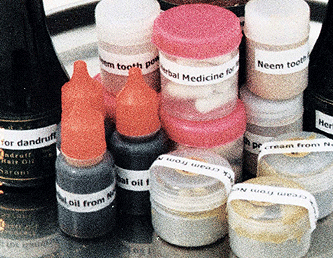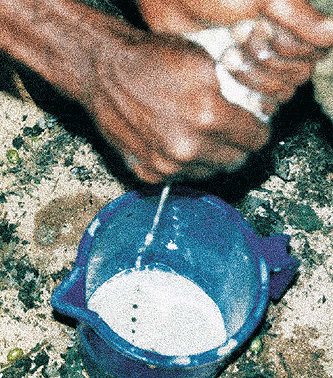 COUNTRY OF ORIGIN
COUNTRY OF ORIGINThe raincoat package for soil, plant, animal and human health
The raincoat package in practice
PEST CONTROL
The introduction of agricultural chemicals in developing countries has often had extremely negative effects, including poisoning and environmental degradation.
Modern research demonstrates that Neem is very effective for pest control. Neem leaves, fruits and seeds are effectively used as a deterrent for many pests. Unlike artificial chemicals, which kill insects that may be useful for eating crop pests, Neem extract does not usually kill insect pests immediately. Instead, it alters the feeding or life cycle of the insect until it is no longer able to live or reproduce. This means that Neem extract takes time to work if the pest attack is severe, and works best as a preventive treatment for the soil and plants. Harmful insects avoid the plants treated with Neem extract, which acts as a screen or raincoat. No harmful residues remain in the soil and environment.
The rain coat preparation is very simple and low-cost, accessible to low-income farmers. It requires ordinary farm equipment like sprayers, a mixer, grinder, mortar and pestle. A presser for extracting the oil is more costly, but selling the oil can be a good source of income. Two ten-year-old trees provide enough pesticide for a normal-sized kitchen herbal garden.
GRAIN STORAGE
Grain storage is another indigenous method developed by the centre for using Neem plant parts. By mixing stored grains with properly dried leaves, pests may be kept away from grains for an entire year. More sophisticated practices may also be learned and applied, but in any case the methodology is simple and requires no machinery. A five-year-old tree is more than sufficient for providing grain storage protection for a family.
MOSQUITO REPELLENT, FERTILIZERS AND ANIMAL FEED
Mosquito repellent, fertilizers and anima feed may be produced from materials left over from oil extraction. Eco-friendly incense sticks that repel flies and mosquitoes are easy to produce; householders as well farmers can prepare them without any costly machinery. Following the extraction of oil an excellent fertilizer as well as animal feed remain to be used at no extra cost.
PRIMARY HEALTH CARE
The Raincoat Package may also be used for primary health care. Neem extract is useful for treating skin disorders, heat rashes, boils, scabies, ulcers and wounds. Neem leaves also help in the treatment of vatic disorders (neuromuscular pains), according to Ayurveda. They are reported to remove toxins, purify blood and neutralize potentially harmful free radicals in the body, and to be beneficial for eye disorders and for treating insect bites. Neem fruits, which are bitter, are purgative, anti-hemorrhoidal and anthelmintic in nature. Neem flowers are astringent, anthelmintic and, of course, non-toxic, and are used to treat conditions and diseases associated with excess heat and cough formation.
Neem seeds, which are also bitter in taste, are anthelmintic, anti-leprotic and may be used as an antidote for poisons. Oil derived from crushing the seed is antidermatonic and also a powerful anthelmintic. It has a wide spectrum of action and is highly medicinal in nature.
The five parts of the Neem tree included in the Raincoat Package are useful together for any vitiated condition of the body, for skin diseases, itching, wounds, burning sensations, excess heat, and other purposes mentioned previously.
THERAPEUTIC PURPOSES
Neem fruits, seed, oil, leaves bark and roots have uses as general antiseptics, antibacterials, treatment of urinary disorders, diarrhoea, fever, and bronchitis, skin diseases, septic sores, infected burns, hypertension and inflammatory diseases. Neem oil and its isolates – nimbidin, nimbidiol and nimbin – inhibit fungal growth on humans and animals. Neem leaf extracts and teas can treat malaria; the anti-malarial action is attributed to gedunin, a limonoid present in the leaves. Azadirachtin or Neem extracts protect from the contact of kissing bugs and parasitic protozoan.
Neem remedies prepared in the home are simple but very effective. No machinery is required, but it is very important to know the proper way to prepare them and the correct dosages. The quality of the raw material is also very important, because the seeds become toxic if they are not properly collected and dried. With improper preparation or use, the home remedies can even be harmful.
A 5-year-old tree is sufficient for producing one family’s home remedies needs.
NEEM OIL
Neem oil is the most commercially important product derived from the Neem plant. It is an important ingredient of many pharmaceuticals and cosmetics preparations not only in India, but also in Europe and the United States. The market demand is increasing and the selling rate is high.
In 1990, India exported about 34 tonnes of Neem oil valued at about 7.500 euro, but with improved collection and use, India could produce about 700.000 tonnes for export. In many parts of India the oil is a good income-generating resource for the rural communities. In the city of Pune, the Kadhi and Village Industries Commission developed a good market of Neem oil on a rational and organised basis. In the state of Tamil Nadu, the Mahakalasam Women’s Federation and the CCD have marketed Neem oil with good economic results. In Kannyakumari NARDEP helps the local Women Self Help Group in the production and marketing of Neem oil.
Producing the oil involves breaking the seeds and separating the kernels to be pressed. The oil yield is sometimes as high as 50 percent of the weight of the kernel. The oil is composed of triglycerides of the following acids: oleic (41%), stearic (20%), linoleic (1%) and palmitic (18%). Each Neem tree produces 5 to 6 kg Neem oil in one year.
The residue of oil extraction can be successfully used in organic farming. It contains more nitrogen, phosphorus, potassium, calcium and magnesium than farmyard manure, and is widely used in India both as a fertilizer and as a pesticide that protects plants’ roots from white ants and nematodes.
DOWNLOAD THE BROCHURE PDF
english (0.7 MB)spanish (0.7 MB)
albanian (0.8 MB)
ONLY TEXT
•The raincoat package in practice







